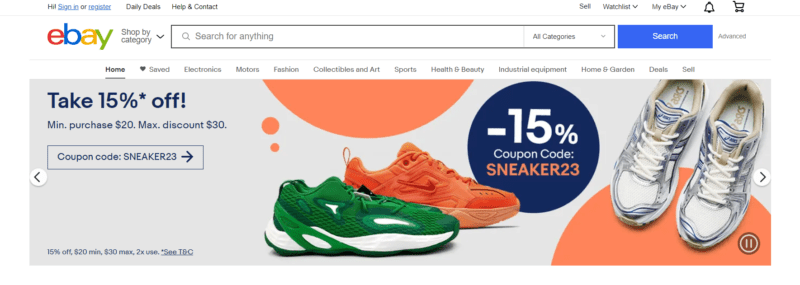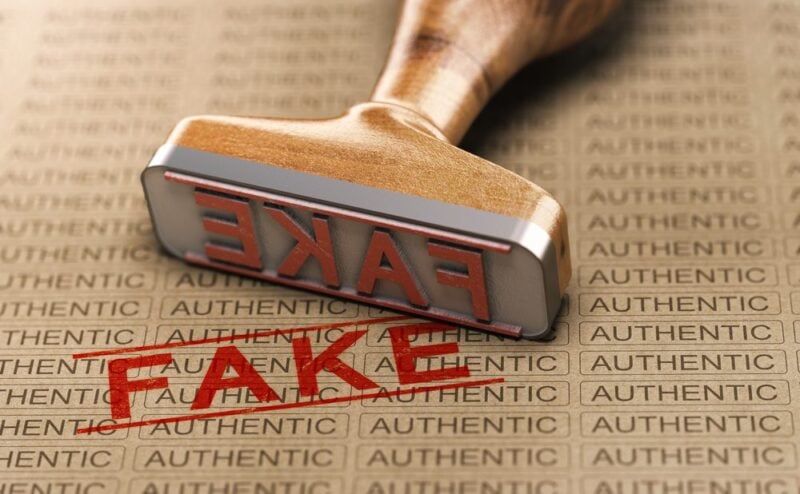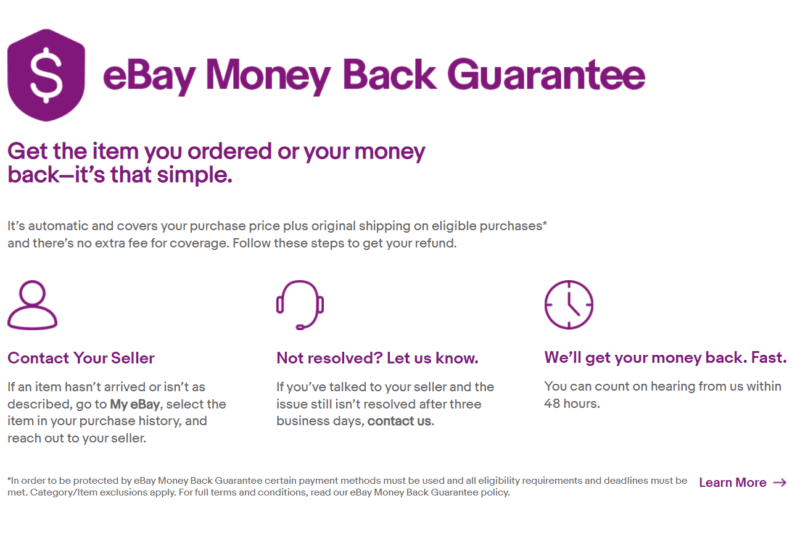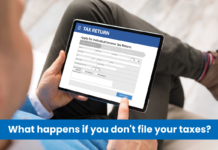
eCommerce platforms such as eBay have become widely popular nowadays, as more and more customers choose to shop online or buy digital services. However, along with its benefits, it has given rise to numerous online frauds and scams that rob innocent people of their hard-earned money. It is essential to be vigilant and safeguard yourself against such fraudulent activities. In this article, we will discuss about various eBay buyer scams and effective strategies that will help you navigate safely through the platform and perform secure transactions.
Table of Contents
How to Avoid eBay Buyer Scam?

eBay stands out as a prominent online marketplace, renowned for its auctions and consumer-to-consumer sales model. It is a favored sales platform for online merchants. Operating across numerous countries, eBay allows users to search for products based on their location by inputting a zip code. Additionally, users can explore products available at a national or international level. Such an online platform offers valuable opportunities to discover bargains or elusive items, but they also draw in deceptive individuals and fraudulent activities.
The craftiest criminals devise tactics to circumvent eBay’s buyer protection mechanisms, tricking potential buyers into sending funds that are non-refundable or sharing sensitive data that could be exploited for identity theft. If you’ve been scammed by a seller while seeking a bargain on eBay, all is not lost. Understanding how to navigate eBay safely is crucial to ensure a positive shopping experience by avoiding fake listings and scammers. Implementing these strategies can help eBay shoppers protect themselves:
- Use Official eBay Channels for Transactions: Always complete transactions through eBay’s official platform to ensure protection. eBay cannot verify deals made outside the platform or monitor private communications.
- Avoid Accepting Checks as Payment: Refrain from accepting checks as they are often targeted for fraud. If accepting checks, wait for them to clear before shipping to prevent potential financial loss.
- Prevent False Chargebacks: Be ready to dispute fraudulent chargebacks with your bank, backed by evidence. Utilize PayPal Protection and consider issuing a refund to avoid chargeback fees.
- Document Every Transaction: Record the packing and shipping process, including tracking numbers and photographs. This documentation can protect you against unfounded fraud claims, especially since eBay tends to favor buyers.
- Utilize Tracking Numbers for Deliveries: Always arrange for a tracking number when sending items, particularly for those valued above $750. Consider requiring a signature on delivery for added security, aligning with PayPal Protection.
- Record Identifying Information: Document unique codes or serial numbers on valuable items, such as electronics. This practice is crucial when purchasing high-demand items to prevent potential eBay buyer scams.
- Verify Item Authenticity: Scrutinize the item’s images and check if they appear on multiple listings. Avoid sellers unwilling to provide additional photos or information, as this could indicate a scam.
- Compare Item Prices: Exercise caution if an item is heavily discounted without a valid reason (e.g., damage). Suspiciously low prices may indicate a scam or stolen property.
- Investigate the Feedback Page: Analyze the seller’s feedback, especially if it consists mainly of low-priced items. Use eBay’s messaging system to inquire about the item’s authenticity and gather more information.
- Examine the Seller Profile: Thoroughly review the seller’s profile, especially for high-value items not covered by the money-back guarantee. Exercise caution and diligence when dealing with expensive items outside policy protection.
- Avoid Rushed Purchases: Carefully read listing details to ensure they match your expectations. Verify item descriptions, as disputes become challenging if the information presented is accurate.
- Handling Misaddressed Parcels: If you receive a misaddressed parcel, check for shipping numbers or transaction codes. Verify the package’s details and contents carefully before taking any action.
Also Read: How to Avoid Cash App Flip Scam?
eBay Scams to Avoid as a Buyer
Purchasing items on eBay is generally uncomplicated, but unfortunately, there are individuals looking to deceive unsuspecting buyers seeking a good bargain. It’s essential to keep in mind that offers that seem exceptionally attractive are likely deceptive. Here are some prevalent scams that eBay buyers should be cautious about:
1. Empty Boxes and Photo Only Scams
eBay scammers employ deceptive tactics by listing popular or hard-to-find items, enticing buyers to make rushed purchases and overlook potential warning signs of a scam. They often present enticing deals on sought-after items such as gaming consoles, video games, or vintage collectibles. However, cunningly hidden within the item description, they may specify that the listing is for the box only, not the actual item.
In another version of this scheme, scammers list high-demand, expensive items at unusually low prices. Discreetly, they mention in the listing that it’s for a photo only or that the actual item may differ from the photos provided. Disappointingly, when the package arrives, all the buyer finds inside is a photograph of the desired item.
The scammer’s strategy revolves around tempting the buyer to act hastily, aiming to capitalize on the desire for a seemingly great deal or the fear of missing out by utilizing eBay’s Buy Now feature. Fortunately, eBay has a No Items Listing Policy, offering some recourse for victims of this eBay buyer scam to potentially recover their money.
- It’s crucial never to rush into a purchase on eBay. Take the time to thoroughly review the listing and carefully examine all the details.
- Read through each listing attentively to ensure a clear understanding of what you will receive.
- If any uncertainty arises regarding the item, its condition, or contents, reach out to the seller through eBay’s messaging system to document the conversation and seek clarifications.
2. Fraudulent Activities Related to Tracking Numbers
![]()
This particular scam exploits eBay’s seller protection program. eBay, in an effort to shield sellers from deceitful buyers who falsely claim non-receipt of their purchased items, mandates the provision of a genuine tracking number for every sale. However, unscrupulous sellers can manipulate this system by deliberately sending a counterfeit package to an incorrect address, allowing them to furnish authentic tracking numbers to both the buyer and eBay.
When the buyer reaches out to the seller to report non-receipt of the item, the seller cites the tracking information indicating delivery, thus evading the need to refund the buyer.
- Before initiating a claim, it’s advisable to contact the seller to investigate if there was an inadvertent error.
- If the seller is uncooperative or if suspicious signs of a scam are evident, it’s crucial to report the matter to eBay.
- Additionally, contacting the local post office to ascertain the delivery details and weight of the package can provide further evidence to support your claim.
3. Failure to Deliver Items not Eligible for eBay Money Back Guarantee
This scam entails sellers failing to deliver the items you’ve paid for. While it may seem reasonable for eBay to reimburse losses in such an obvious eBay buyer scam, there are specific scenarios where purchases fall outside eBay Money Back Guarantee. You will not be reimbursed for undelivered items in the following cases:
- Digital content (including NFTs and other intangible goods)
- Real estate, websites, and businesses for sale
- Services
- Travel tickets or vouchers
- Classified ads
- Motor vehicles (covered by Vehicle Purchase Protection instead)
- Certain types of business equipment
To protect yourself from scams, follow these guidelines:
- Watch for red flags like not receiving a tracking link or receiving non-functional tracking information.
- Try to steer clear of purchasing items in categories not covered by eBay Money Back Guarantee.
- Review the seller’s terms to ensure you’re protected if they fail to send the item.
- Prior to purchasing, read reviews and feedback to see if any previous buyers have reported being scammed by the seller.
4. Misleading Shipping by Using Incorrect Recipient Names
In this scheme, scammers follow through with the expected sale process smoothly, providing you with a tracking number and completing the payment without any apparent issues. However, upon receiving the package, you notice that while it displays your correct mailing address, it’s actually addressed to a different individual. The scammers rely on you assuming this is a genuine mistake and proceeding to return the package. If you do so, eBay will categorize the transaction as returned or refused, effectively removing your coverage under eBay Money Back Guarantee and preventing you from disputing the sale.
- To navigate this situation, first, check the tracking information to confirm if the item has been marked as delivered, indicating that the package is intended for you.
- Then, verify the address on the package. If it matches yours, proceed to open the package to inspect its contents and check for any order receipts.
- If the contents don’t align with what you ordered or if there’s any discrepancy, promptly contact eBay to report that the item does not match the listing.
5. Illicit Trade of Counterfeit or Inauthentic Products

eBay hosts a wide array of genuine, high-quality products, but unfortunately, there are individuals who misuse the platform to promote counterfeit or deceptive items, attempting to deceive buyers into paying full price for them. These listings often assert authenticity and feature images, which can either be stolen or fabricated, giving the impression of a genuine product. Exercise heightened caution when navigating eBay listings through social media links. Some fraudsters utilize social posts to advertise authentic items, redirecting to eBay listings for fake, fraudulent, or unbranded versions.
- Thoroughly scrutinize a seller’s reviews. Many scammers adopt a tactic of initially selling inexpensive items to bolster their overall ratings before attempting to scam buyers with more costly offerings.
- In the event that a listing claims authenticity but delivers a counterfeit item, promptly report the issue to eBay and request a refund.
- Exercise prudence when considering purchases of authentic items at significantly discounted prices. Prior to making a purchase, communicate with the seller through eBay’s messaging system to request additional information that can aid in validating the item’s authenticity.
- Verify the listing’s images to ascertain if they are stock photos or appear on other platforms. Conduct a reverse-image search using particular tools to determine if the images are utilized elsewhere.
6. Triangulation Fraud in Online Transactions
Triangulation fraud represents a complex eBay scam wherein deceitful sellers utilize stolen credit card details to divert funds from unsuspecting victims. Here’s a breakdown of how this scheme operates:
- eBay users make regular purchases from a seller.
- Upon package receipt, buyers find an additional, high-value item they didn’t purchase.
- When contacting the seller, they claim it was sent by mistake and offer it as a free gift.
- In reality, the seller exploits stolen credit card numbers to purchase these goods, keeping the funds sent by the buyer.
- When the rightful credit card owner discovers the fraud, they file a chargeback, usually covered by their bank or the involved business.
This scam is challenging to detect because, at first glance, it seems like everyone benefits. The buyer receives an unexpected valuable item, and eBay earns a percentage from the sale. However, accepting goods bought with a stolen credit card can jeopardize the buyer, potentially resulting in account loss or investigation for involvement in the fraud.
- When a deal appears exceedingly advantageous, exercise caution, especially with common items listed significantly below market prices.
- Opt for established eBay sellers with extensive selling history and positive feedback.
- If a free item accompanies your purchase unexpectedly, assume foul play involving stolen credit cards and promptly report the scammer to eBay support.
7. Requesting Payment External to eBay’s Platform
eBay’s security measures and policies provide protection exclusively when transactions take place directly on their platform. If a seller insists on off-platform payments, particularly through methods lacking reversibility or traceability like wire transfers, gift cards, cryptocurrency, Zelle, or Venmo, it’s almost certainly an eBay buyer scam. Once the seller obtains your funds or bank account details, they will cease communication and fail to deliver the promised item. Regrettably, using a non-approved payment method means you cannot dispute the transaction.
- It’s crucial to be well-versed in eBay’s payment policy and strictly employ authorized payment methods.
- Conduct all communications and payments within eBay’s system to benefit from their buyer protection program.
- When making online purchases, opt for payment methods that offer reversibility or possess a strong track record of safeguarding buyers.
8. Phishing Attempts via Email

Experiencing the frustration of narrowly missing out on a desired item can be quite disheartening. That’s why eBay has a legitimate program called Second Chance Offer, enabling sellers to offer items again when they have more available, the winning bidder didn’t follow through, or the reserve price wasn’t met. However, it’s unfortunate that scammers exploit this system in various ways:
- They send deceptive emails to eBay users who were unsuccessful in winning an auction, falsely claiming a second chance opportunity to purchase the item.
- Scammers use eBay’s messaging system to falsely indicate a second chance to purchase an item. They then request the purchase price to be wired to a non-eBay email address, often assuming the guise of a legitimate seller whose account has been compromised or who is unaware of the situation.
If you fall for a fake second chance offer, you’ll end up paying the scammer without ever receiving the item. To safeguard yourself from these scams, follow these steps:
- When receiving a Second Chance Offer, verify that the message appears both in your eBay message inbox and the Bids/Offers section of your My eBay page.
- Scrutinize the email subject line meticulously, as eBay never uses a subject line stating, Message from eBay Member. If you suspect a fake email, forward it to spoof@ebay.com.
- Avoid wiring money to a seller or sending a direct check.
- Ensure all communications and payments occur within the eBay platform. Never allow the seller to convince you to shift the conversation to an off-site email or messaging platform.
9. Scams Targeting eBay Motors Transactions
Purchasing a car through eBay Motors offers convenience, but it also puts you at risk of encountering scammers due to the substantial nature of the transaction. In an eBay Motors scam, con artists craft a vehicle listing accompanied by a poignant narrative explaining their urgent need to sell the car—often revolving around a sick family member or imminent military deployment. Subsequently, they request a wire transfer or another irreversible form of payment before claiming to ship the vehicle to you. Unfortunately, after sending the funds, it becomes evident that the advertised vehicle doesn’t exist. There are clear indicators of an eBay Motors scam, including:
- Claims that paperwork and the vehicle are held in a non-existent eBay warehouse.
- A seller reluctant to meet in person.
- Demands for extra fees related to shipping, fuel, or miscellaneous costs.
- High-pressure tactics to rush the transaction.
- The seller offering to manage the shipping process (typically the buyer’s responsibility).
- Deals that appear too good to be true, often accompanied by a heartfelt backstory for selling the vehicle.
To safeguard against scams, follow these guidelines:
- Familiarize yourself with eBay’s vehicle sales procedures, understanding your responsibilities and protections during the transaction.
- Always log in to eBay or use their mobile app to search for a car or other vehicle and complete the checkout directly through eBay.
- While a deposit might be necessary for a vehicle purchase, refrain from making payments using untraceable methods such as gift cards or wire transfers.
10. Provision of Bogus eBay Customer Service Contact Numbers
Scammers are aware that their chances of successfully scamming individuals increase when they engage them through phone communication. One prevalent eBay buyer scam involves the creation of counterfeit eBay customer support phone numbers, which are strategically placed on product listings, profiles, or within search result-related websites. When a buyer encounters an issue with their purchase and attempts to reach out for assistance, the fraudsters deceive them into providing personal or financial details under the guise of resolving the problem.
In certain instances, these fraudulent customer support representatives may coerce victims into downloading software that grants them remote access to their computers. It’s crucial to avoid this at all costs, as it can compromise not only the individual’s eBay account but also their passwords and sensitive data.
- It’s a best practice to always sign into your eBay account before reaching out to eBay support, ensuring that you utilize an official and secure contact method rather than risking the use of a potentially hazardous phone number.
- Additionally, it’s important never to disclose passwords, PINs, 2FA codes, or any sensitive information (like your SSN) over the phone, as authentic representatives from eBay will never request such information.
11. Gift Card Scam

Scammers employing gift card fraud often reach out to potential victims via phone, email, or social media. They employ tactics like offering time-sensitive discounts to create a sense of urgency. The scammer then requests the victim to provide the gift card number, which they deceitfully claim is for payment purposes. Once they obtain this code, they vanish, absconding with the victim’s gift card balance. To safeguard against gift card scams, it’s essential to adhere to these guidelines:
- Treat your eBay gift card redemption code with the same caution as you would treat cash.
- Refrain from sharing your gift card code with anyone under any circumstances.
- Exclusively redeem your gift card during the checkout process on eBay.com.
- Avoid using your gift card for transactions outside of eBay; stick to authorized platforms.
- If a seller insists on payment via gift card, do not proceed with the transaction – it’s undoubtedly an eBay buyer scam.
Cross-Reference: I could prove I had been scammed but eBay wasn’t on my side
What to Do if You Get Trapped in eBay Buyer Scam?
If you find yourself a target of an eBay buyer scam, taking specific actions can aid in recovering your funds and safeguarding others from falling victim to the scam:
- Initiate a refund request with the seller. eBay will only intervene after attempting resolution with the seller.
- Exercise caution with sellers who repeatedly delay or offer excuses while claiming to address the issue. They might be prolonging the scam to avoid detection.
- If you’re unable to resolve the problem directly, promptly report the seller to eBay.
- Subsequently, provide negative feedback about the seller to alert and caution potential buyers.
- If your payment was made through a different platform, follow the respective procedure to request a refund.
- Should the scam involve payments through Zelle, Venmo, or Cash App, familiarize yourself with the appropriate steps to take.
- If the scammers have accessed your personal or financial information, maintain vigilance by monitoring your credit report for any signs of fraudulent activity or potential identity theft.
Signs of an eBay Scammer
While strategies for scamming on eBay can vary, there are consistent warning signs to watch for whether you’re buying or selling on the platform. Essentially, if an offer seems too good to be true, exercise caution. Here are key indicators of potential eBay buyer scams to be vigilant about:
- Limited or No Seller Feedback History: The seller may have little or no feedback, which could be a red flag.
- Poor Spelling and Grammar in Item Description: If the item description is riddled with spelling and grammar errors, exercise caution.
- Short Listing Duration: Listings that are only posted for a short period may be suspicious.
- Unrealistically Low Price: If the price for an item seems significantly below the market value, it could be a scam.
- Beware of Unrealistically Discounted Deals: Be cautious of deals that seem too good to be true, especially if they involve heavy discounts on high-value or hard-to-find items like iPhones or electronics.
- Use eBay’s Official Payment and Communication System: Transactions or communications outside of eBay’s platform can put you at risk and may violate eBay’s policies.
- Avoid Untraceable Payment Methods: Refrain from using payment systems that cannot be reversed, such as cryptocurrencies, wire transfers, Cash App, Zelle, or Venmo.
- Inconsistent Feedback and Item Types: Sellers with feedback only for low-value items but suddenly selling luxury goods should raise suspicion.
- Unexpectedly Long Shipping Timelines: If the shipping timelines provided are unusually long, exercise caution.
- Inclusion of a Sob Story in Item Description: The presence of a sob story in the item description could be an attempt to deceive.
eBay Money Back Guarantee Cover

eBay Money Back Guarantee serves as a protective measure for both buyers and sellers, contingent upon adherence to eBay’s stipulated policies. For instance, to qualify for a refund, it’s essential to complete the transaction and make the payment for items through eBay using an approved payment method. In the capacity of a buyer, you can avail eBay Money Back Guarantee if:
- The item you purchased wasn’t received within the promised timeframe by the seller.
- The item you receive doesn’t align with the seller’s provided listing, encompassing scenarios like receiving an incorrect or damaged item.
- You attempt to return an item, but the seller doesn’t comply with the policy outlined in their listing.
- The item you purchased is not listed on eBay’s excluded item list.
As a seller, it’s mandatory to uphold eBay’s policies, including:
- Accurately describing and delivering items in accordance with the listing.
- Honoring the stated return policy and facilitating returns.
- Resolving issues promptly if a buyer reports a problem.
- Adhering to the prescribed timeframes of eBay’s platform for taking necessary actions.
What is eBay PayPal Scam?
The eBay PayPal scam occurs when genuine buyers make a purchase on eBay using PayPal and then falsely claim that the item either wasn’t received or was damaged. They do this to exploit buyer protection and receive a refund without having to return the item. For sellers, this can be incredibly frustrating since they end up losing both the item and the payment they received.
Nevertheless, sellers can mitigate this through the seller protection program by furnishing shipment tracking numbers and other necessary details via PayPal’s resolution center. Scammers employ various methods to deceive individuals into divulging personal information or believing they have received a payment. If you receive an email resembling communication from PayPal regarding an eBay transaction, be vigilant for these warning signs:
- Grammatical and spelling inaccuracies,
- Solicitation for your PayPal email address,
- Solicitation for postal tracking numbers,
- Solicitation for financial and personal details,
- Use of generic greetings,
- Sender’s email address not originating from PayPal.
To safeguard against fraudulent eBay PayPal scams while using eBay, follow these precautionary steps:
- Verify PayPal Activity Before Shipment: Before sending any items, verify the funds in your PayPal account by directly logging into it. If the claimed funds are not present, the email is likely fraudulent. Authentic PayPal communications can also be viewed within your PayPal account.
- Avoid Clicking Email Links: If the email purportedly from PayPal contains links, refrain from clicking on them. These could be phishing attempts, aiming to compromise your personal or financial data. Clicking may also install harmful viruses on your device.
- Conduct Transactions Within eBay: Ensure that all communication and transactions occur within eBay’s platform. eBay provides a secure environment for processing sales, and buyers should not require your email address to complete a transaction. Stick to eBay’s built-in features to maintain safety and transparency.
What to Do if You Get Trapped in eBay PayPal Scam?

- Initiate an Inquiry on eBay: Begin the process of addressing a non-paying bidder issue through the eBay Resolution Center. Explain the situation where the buyer has sent a fraudulent PayPal email falsely indicating payment when no actual funds have been transferred. Include any supporting documentation, such as the misleading email you’ve received.
- Report eBay PayPal Scam: Lodge a formal complaint with the Federal Trade Commission (FTC) via its online complaint platform. Additionally, it’s advisable to notify your local law enforcement authorities about the online fraud you’ve encountered.
- Notify PayPal About the Phishing Email: Inform PayPal about the receipt of a deceptive email by forwarding it to spoof@paypal.com. PayPal will conduct an investigation to confirm the email’s fraudulent nature.
- Safeguard Your Device: In case you’ve clicked on any links in the fake eBay PayPal scam email, take measures to ensure your device’s security. Run a comprehensive anti-malware scan to identify and remove any potential malware that might have been installed on your computer as a result of clicking the link.
- Contact Your Financial Institution: Reach out to your financial institution and any cards linked to your PayPal account. Notify them about the possibility of a scammer gaining access to your funds. They might require you to cancel your existing cards and issue new ones for added security.
Also Read: How to Avoid Getting Scammed on PayPal? Best Tips and Tricks
eBay Scams to Avoid as a Seller
It could be unexpected, but a considerable number of eBay scams don’t prey on naive buyers seeking attractive deals. Rather, scammers frequently masquerade as buyers and exploit consumer protection mechanisms to deceive honest sellers. Let’s delve into some prevalent methods scammers employ to defraud eBay sellers.
1. Offer to buy privately outside eBay
A potential buyer might come across your item and propose a private transaction outside of eBay, suggesting this way both parties can avoid paying eBay’s transaction fees. However, if you agree and close the listing, sending the item, there’s a risk that the buyer may not pay or dispute the transaction through eBay, claiming the item was damaged or the listing was fraudulent.
2. Overpayment Offer
When selling an item, a buyer might contact you and offer to pay more than the listed price. While this might seem like a good deal initially, it could be a scam. The buyer might use a fraudulent check for payment. You send the item, but later discover the cheque bounces, leaving you with no payment and no item.
3. Change of Address Scam
A variation of the overpayment scam involves a buyer offering to purchase your item and sending an excessive payment. They claim it’s to cover additional shipping costs as they now want it sent to a foreign country. They may also request your PayPal email. Subsequently, scammers posing as PayPal representatives ask for tracking numbers, claiming the payment will be released once proof of shipment is provided. Unfortunately, it’s a scam, and you’ll lose both the money and the item.
4. Empty Box Claim

In this scenario, the purchase appears to go smoothly. The buyer pays promptly, and you ship the item without issues. However, the buyer receives the item and falsely claims that you sent an empty box, alleging fraud. eBay will demand a return, and the buyer sends an empty box back to you, keeping both the item and the money once it’s refunded.
5. Buyer Claims Non-Receipt
Experienced scammers might exploit sellers who are unaware of the additional burden of proof needed for high-value items. They claim the item was not received, demand a refund, and make off with the expensive item. PayPal Seller Protection requires proof of item delivery, including signature delivery proof for high-value items.
6. Broken Replica Scam
A buyer purchases your item, and after payment is confirmed, you promptly ship it. However, the buyer accuses you of sending a damaged item, even providing photos. Unbeknownst to you, the item they claim is damaged is a replica. They report it to eBay as damaged, get a refund, and you’re left without both your item and the payment.
7. Unjustified Chargeback
Exploiting the buyer-favoring nature of transaction platforms, scammers can cancel a transaction by contacting the payment provider after completing the purchase. They can easily claim suspicion or a problem, resulting in a chargeback. This leads to money being recovered from you and additional chargeback fees.
8. Feedback Extortion
Understanding the significance of building an online reputation on eBay, scammers might purchase from you and then demand additional payment through private channels, threatening negative feedback if you don’t comply. As completed feedback cannot be disputed, this puts sellers in a position where they may feel compelled to agree to avoid harm to their account’s reputation.
Also Read: Does PayPal Refund Money if Scammed? Full Guide
While eBay offers a platform for safe purchases, buyers should remain on guard to avoid potential scams. You should exercise caution, verify sellers, and prioritize secure payment methods for a secure online shopping experience.
Source: eBay Security Center


